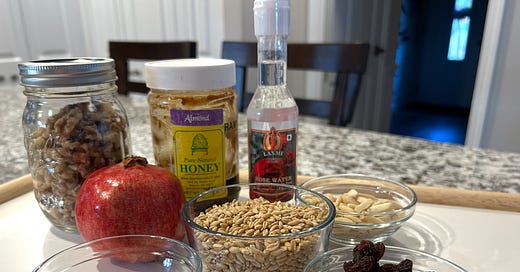Cooking Around the World Part 1: Armenia
Self-Care and Creativity Through Cooking: A is for Armenia.
Back in November, I wrote about a bit about how I was feeling after in the days after the 2024 Presidential Election. I am still not over it, but am finding ways to cope and prepare for what many of us in society will be up against in not only the next four years, but for who knows how much longer into the future.
TLDR: To give me a creative and structured goal for 2025, (that allowed me to focus on the world around us and not the one we might soon living in) I decided to find 26 new recipes - two a month, and each from countries from A-Z - to make and write about.
As I tend to do with new projects, I dove right into organizing. Looking at recipes, making lists of countries, doing initial research into recipes that looked interesting to me.
For my first recipe, I wanted to do something that represented traditional recipe that is made in observance of, and to start of on a good foot in the New Year. The “A” countries on my list are Armenia, Albania, Argentina, Afghanistan, and Austria. From that list, I started looking for traditional New Year’s recipes, and decided on the coincidently named Anoush Abour, or Armenian Christmas Pudding.
A very simple history of this dish (according to my sources below) is that Anoush Abour in Armenian means “sweet soup”, is meant to start the new year off on a sweet note, and is traditionally served on Christmas (which is celebrated in Armenia on January 6) and New Year’s tables. Simple in preparation, and adaptable with regard to ingredients, it seemed to be the perfect dish to break in this new column and to welcome 2025.
Similar in concept to a porridge or oatmeal, the base of Anoush Abour is a grain. Different recipes call for different options, pearled barley, wheat berries, farro, or bulghur. I am lucky to have access to about a half a dozen great Mediterranean and Middle Eastern markets, and it was easy to find whole wheat berries, which is what I used.
For the last few years, my favorite way to ring in the new year has been to ignore the normal new year’s festivities, be asleep before midnight, and wake up early to greet the new year. So I felt it was the perfect time to try this recipe and spend the first morning of 2025 cooking and writing. The ingredients I used for two servings are:
Whole wheat berries (1/4 cup)
Water (2 1/2 cups)
Dried apricots (3, chopped)
Raisins (1 tablespoon)
Craisins (1 tablespoon)
Toasted almond slivers (3 tablespoons)
Honey (1 tablespoon, or to taste)
Pomegranate seeds
Cinnamon (dash, or to taste)
Rose water (dash, or to taste)
The recipe itself is forgiving, and the steps are easy enough to follow for a beginner. The recipe can easily scaled up for a bigger yield, and you can add any dried fruits or nuts you’d like. You can also substitute orange blossom water for the rose water.
Bring the water to a boil and add in the wheat berries, and drop the flame from a boil to a simmer.
Cook the berries for 30 or so minutes until the water starts to absorb, and the berries soften. You can add more water if needed. Stir occasionally.
Once the berries are soft, add in your dried fruit, the honey, the cinnamon and the rose water. Continue to stir occasionally until the honey, rose water are absorbed. It will start to smell delicious at this point.
When liquid absorbs, and the berries are soft, remove from the stove, plate, and then garnish with the almond slivers and pomegranate seeds. Some use the pomegranate seeds to spell out the year as an official nod to the turning of the calendar (which I attempted to do, but may not have had a big enough of a wheaty canvas to work with).
Serve warm.
When this all came together, it really was delicious. The wheat berries didn’t breakdown into an “oatmealy” consistency, but kept their integrity. The dried fruit, honey, and rose water definitely reaffirm the idea of “sweet soup”, but the addition of the pomegranate seeds add a welcome tartness, and the almonds add a lovely crunch. I would be curious to see if any of the other grain choices would result in a creamier texture. I might try adding a scoop of chilled down Anoush Abour to Greek yogurt as an another option.
I’m glad I chose this as my first recipe. Happy 2025.
Thanks for stopping by. This episode of “Let’s Eat” is free, so feel free to share.
Enjoying kimchantment? You can also share the full site with others.
Join The 19 Club for access to subscriber-only content.
Click here for more “Let’s Eat” posts.
Join kimchantment on Instagram.
Visit the full kimchantment site.
The recipe sources I used include Taste Atlas, Priya’s Versatile Recipes and Wanderlust and Lipstick.
© 2025 Kim Selby & Storm Your Brain, LLC. All rights reserved. All photography © Kim Selby unless otherwise credited.





